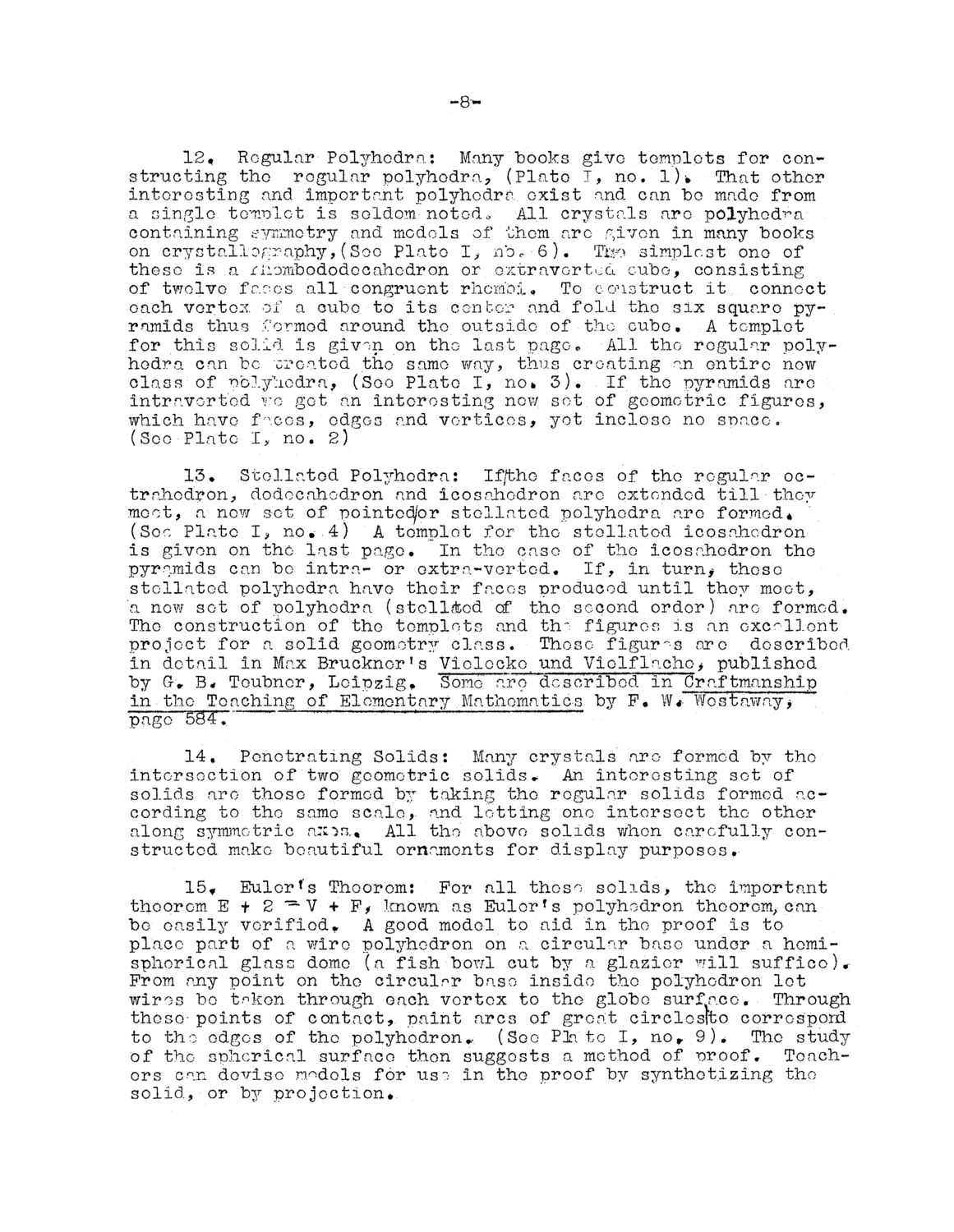| |
| |
Caption: Mathematical Models Construction and Use of Mathematical Models (Fehr & Hildebrandt)
This is a reduced-resolution page image for fast online browsing.

EXTRACTED TEXT FROM PAGE:
~8- 1 2 , Regular Polyhcdra; Many books give templets for constructing the regular polyhedra, (Plato I, no. l)» That other interesting and Important polyhcdra exist and can be made from a single, templet is seldom-noted,. All crystals arc polyhcdra containing symmetry and models of them are f^ivon in many books on crystallography,(See Plato I, nbc 6 ) . Tbo simplest one of these is a riiombododecahodron or cxtraverted cube, consisting of tv/olvc faces all congruent rhombi. To construct it., connect each vortex of a cube to its con tor and fold the six square pyramids thus formod around the outside of the cube* A templet for this solid is given on the last pagec All the regular polyhcdra can be created the same way, thus creating an entire new class of nblyhodra, (See Plate I, no* 3 ) . If the pyramids are intravortod ro get an interesting new sot of geometric figures, which have faces, edges and vortices9 yet inclose no snaco, (See Plate 1 / no. 2) 13» Stellated Polyhcdra: If/tho faces of the regular octrahedron^ dodecahedron and icosahodron arc extended till thoy moot, a n e w set of pointed/or stellated polyhedra arc formed* (Sec Plato I> no* 4 ) A templet for the stellated icosahodron is given on the last page. In the case of the icosahodron the pyramids can be intra- or extra-verted. If, in turn^ these stellated polyhcdra have thoir faces produced until thoy meet, a now set of polyhedra (stell*cd of the second order) are formed. The construction of the templets and th~ figures is an excellent project for a solid geometry class. These figures ore described in detail in Max Brucknerrs Vielocke und Vielflache^ published by Gr B# Teubner, Leipzig• Some are described in Craftmanshlp in the- Teaching of Elementary Mathematics by P» W# Westaway* page 5^4•" 14. Penetrating Solids: Many crystals are formed by the intersection of two geometric solids* An interesting set of solids are those formed by taking the regular solids formed according to the same scale, and letting one intersect the other along symmetric a;nn,t All the above solids when carefully constructed make beautiful ornaments for display purposes. 15* Eulcr!'s Theorem: For all these solids, the important theorem E + 2 ~ V + F, known as Eulorrs polyhedron theorem, can be easily verified,, A good model to aid in the proof is to place part of a wire polyhedron on a circular base under a hemispherical glass dome (a fish bowl cut by a glazier will suffice)* Prom any point on tho circular base inside the polyhedron lot wires be t.^kon through each vortex to tho globe surface. Through these-points of contact, paint arcs of great circlosfto correspond to tho edges of the polyhedron., (Soe Pla to I, nor 9 ) . Tho study of the spherical surface then suggests a method of nroof. Teachers can devise models for use in the proof by synthotizing the solid, or by projection*
| |